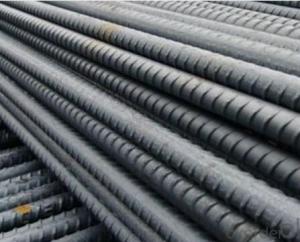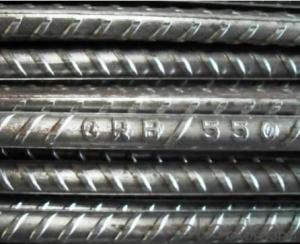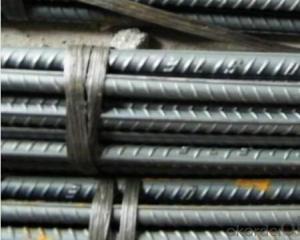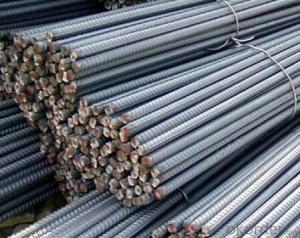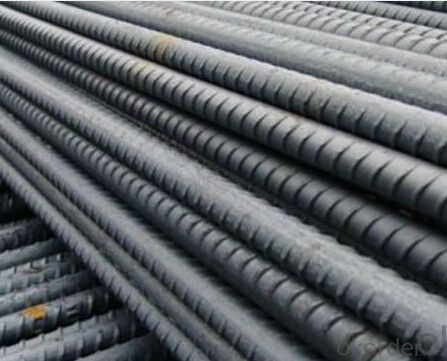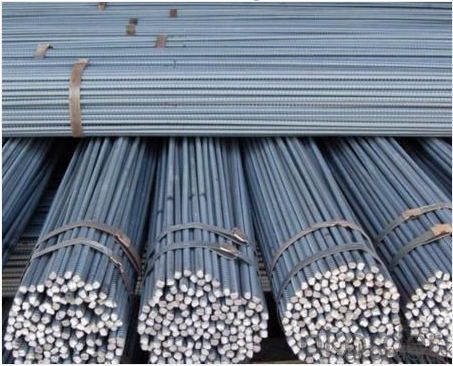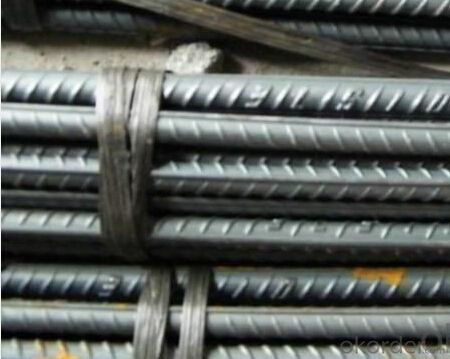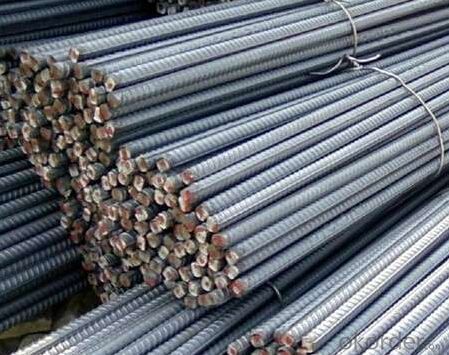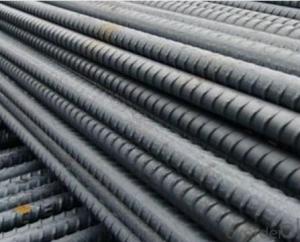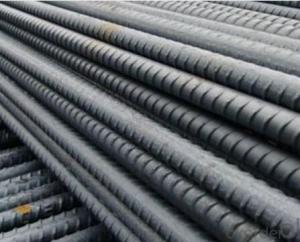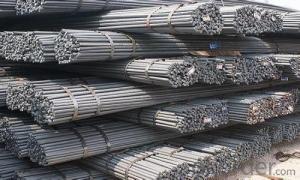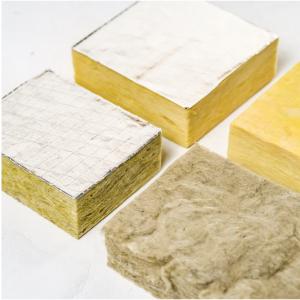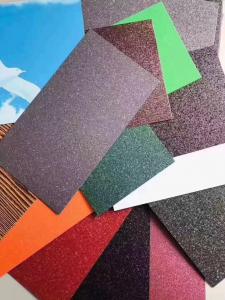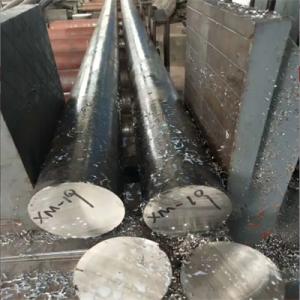Rebar #5 Weight Deformed Steel Bar with Standard ASTM A615
- Loading Port:
- Tianjin
- Payment Terms:
- TT OR LC
- Min Order Qty:
- 100 m.t.
- Supply Capability:
- 5000 m.t./month
OKorder Service Pledge
OKorder Financial Service
You Might Also Like
Product Description:
OKorder is offering Deformed Steel Bar with Standard ASTM A615 at great prices with worldwide shipping. Our supplier is a world-class manufacturer of steel, with our products utilized the world over. OKorder annually supplies products to European, North American and Asian markets. We provide quotations within 24 hours of receiving an inquiry and guarantee competitive prices.
Product Applications:
Deformed Steel Bar with Standard ASTM A615 are ideal for structural applications and are widely used in the construction of buildings and bridges, and the manufacturing, petrochemical, and transportation industries.
Product Advantages:
OKorder's Deformed Steel Bar with Standard ASTM A615 are durable, strong, and resist corrosion.
Main Product Features:
· Premium quality
· Prompt delivery & seaworthy packing (30 days after receiving deposit)
· Corrosion resistance
· Can be recycled and reused
· Mill test certification
· Professional Service
· Competitive pricing
Specifications of Deformed Steel Bar with Standard ASTM A615:
Standard | GB UK USA | HRB335 HRB400 HRB500 G460B, B500A, B500B,B500C GR40, GR60 | |
Diameter | 6mm,8mm,10mm,12mm,14mm,16mm,18mm,20mm, 22mm,25mm,28mm,32mm,36mm,40mm,50mm | ||
Length | 6M, 9M,12M or as required | ||
Packing | Export standard packing: wrapped by wire rod in bundles | ||
Each bundle weight | 2-3MT, or as required | ||
Trade terms | FOB, CFR, CIF | ||
Payment terms | TT payment in advance or Irrevocable LC at sight. | ||
Delivery Detail | within 45 days after received advanced payment or LC. | ||
Brand name | DRAGON | ||
Theoretical weight and section area of each diameter as below for your information:
Diameter(mm) | Section area (mm²) | Mass(kg/m) | Weight of 12m (kg) | Pcs/ton |
6 | 28.27 | 0.222 | 2.664 | 375.38 |
8 | 50.27 | 0.395 | 4.74 | 210.97 |
10 | 78.54 | 0.617 | 7.404 | 135.06 |
12 | 113.1 | 0.888 | 10.656 | 93.84 |
14 | 153.9 | 1.21 | 14.52 | 68.87 |
16 | 201.1 | 1.58 | 18.96 | 52.74 |
18 | 254.5 | 2.00 | 24 | 41.67 |
20 | 314.2 | 2.47 | 29.64 | 33.74 |
22 | 380.1 | 2.98 | 35.76 | 27.96 |
25 | 490.9 | 3.85 | 46.2 | 21.65 |
28 | 615.8 | 4.83 | 57.96 | 17.25 |
32 | 804.2 | 6.31 | 75.72 | 13.21 |
36 | 1018 | 7.99 | 98.88 | 10.43 |
40 | 1257 | 9.87 | 118.44 | 8.44 |
50 | 1964 | 15.42 | 185.04 | 5.40 |
Chemical Composition: (Please kindly find our chemistry of our material based on JIS as below for your information)
JISG3112 SD390 | Chemical Composition | ||||
C | Mn | Si | S | P | |
0.22 | 1.38 | 0.4 | 0.014 | 0.022 | |
Physical capability | |||||
Yield Strength(N/cm²) | Tensile Strength(N/cm²) | Elongation (%) | |||
620 | ≥400 | 21 | |||
The production process of Deformed Steel Bar with Standard ASTM A615
1-Waling beam furnace
2-Roughing rolling group
3-Intermediate rolling train
4-Finishing rolling group
5-Water-cooling device
6-Walking beam cooler
7-Finishing equipment(including the cold scale shear,short feet collection system,
automatic counting device,bundling machine, collect bench)
Usage and Applications of Deformed Steel Bar with Standard ASTM A615:
Deformed bar is widely used in buildings, bridges, roads and other engineering construction. Big to highways, railways, bridges, culverts, tunnels, public facilities such as flood control, dam, small to housing construction, beam, column, wall and the foundation of the plate, deformed bar is an integral structure material. With the development of world economy and the vigorous development of infrastructure construction, real estate, the demand for deformed bar will be larger and larger..
Packaging & Delivery of Deformed Steel Bar with Standard ASTM A615:
Packaging Detail: products are packed in bundle and then shipped by container or bulk vessel, deformed bar is usually naked strapping delivery, when storing, please pay attention to moisture proof. The performance of rust will produce adverse effect.
Price: Keep lower operating costs so as to offer competitive price for our clients
FAQ:
Q1: Why buy Materials & Equipment from OKorder.com?
A1: All products offered byOKorder.com are carefully selected from China's most reliable manufacturing enterprises. Through its ISO certifications, OKorder.com adheres to the highest standards and a commitment to supply chain safety and customer satisfaction.
Q2: How do we guarantee the quality of our products?
A2: We have established an advanced quality management system which conducts strict quality tests at every step, from raw materials to the final product. At the same time, we provide extensive follow-up service assurances as required.
Q3: How soon can we receive the product after purchase?
A3: Within three days of placing an order, we will begin production. The specific shipping date is dependent upon international and government factors, but is typically 7 to 10 workdays.
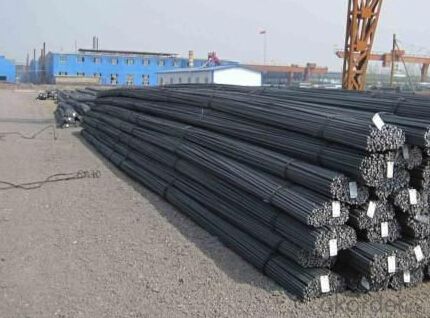
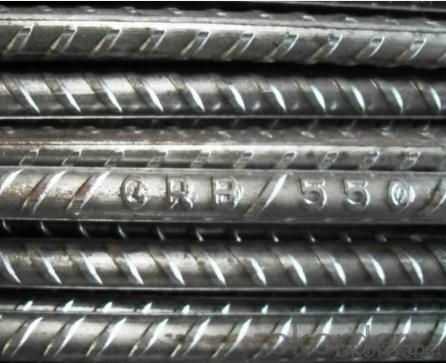
- Q:Can steel rebars be used in tunneling and mining operations?
- Yes, steel rebars can be used in tunneling and mining operations. Rebars, which are steel bars commonly used to reinforce concrete structures, can also be employed in underground construction projects such as tunnels and mines. These steel bars provide additional strength and stability to the structures in these environments, ensuring durability and safety. In tunneling projects, rebars are often embedded in shotcrete or concrete linings to enhance the structural integrity of the tunnel walls and prevent collapse. Similarly, in mining operations, rebars are used to reinforce the roofs, walls, and support structures within the mine, safeguarding against potential hazards such as rockfalls and cave-ins. The use of steel rebars in tunneling and mining operations is crucial for maintaining the integrity and stability of these underground structures.
- Q:Can steel rebars be used in structures with limited construction permits?
- Steel rebars can typically be used in structures with limited construction permits, as they are commonly used in construction due to their strength and durability. However, it is important to consult the specific regulations and limitations outlined in the construction permits. These permits may have restrictions on the types of materials that can be used, including the size and composition of rebars. It is advisable to consult with a structural engineer or the local building authority to ensure compliance with the construction permits and to determine if steel rebars are allowed in the particular structure.
- Q:What are the common sizes of steel rebars used in construction?
- The sizes of steel rebars used in construction can vary depending on the specific application and engineering requirements. However, there are several standard sizes that are widely used in the industry. The industry commonly utilizes rebar sizes ranging from #3 to #18. These numbers represent the diameter of the rebar in eighths of an inch. For instance, a #3 rebar has a diameter of 3/8 inch, while a #18 rebar has a diameter of 2 1/4 inches. Regarding metric measurements, the most frequently used rebar sizes range from 10mm to 40mm in diameter. These sizes are typically designated by their nominal diameter in millimeters, such as 10mm, 12mm, 16mm, 20mm, 25mm, 32mm, and 40mm. The selection of the appropriate rebar size depends on various factors, including the required load-bearing capacity, the structural design, and the type of construction project. Smaller diameter rebars, like #3 or 10mm, are typically utilized in lighter construction projects or for smaller concrete elements like walls or slabs. Conversely, larger diameter rebars, like #18 or 40mm, are commonly employed in heavy-duty applications such as bridges, high-rise buildings, or large-scale infrastructure projects. It is important to note that different countries or regions may have their own specific standards regarding rebar sizes. Consequently, it is crucial to consult local building codes and regulations to ensure compliance.
- Q:How do steel rebars affect the overall noise insulation of a structure?
- Steel rebars have a minimal impact on the overall noise insulation of a structure. This is because noise insulation primarily depends on the density and thickness of the materials used in the construction of walls, floors, and ceilings. Steel rebars, being used to reinforce concrete structures, do not significantly contribute to the sound insulation properties of a building. The primary function of steel rebars is to provide strength and stability to the concrete, ensuring its structural integrity. They are typically embedded within the concrete, resulting in their presence throughout the building's framework. However, the steel rebars themselves do not possess any sound-absorbing or sound-blocking characteristics. To enhance the noise insulation of a structure, other sound insulation materials such as insulation boards, acoustic panels, or soundproofing materials need to be incorporated into the building design. These materials are specifically designed to absorb or block sound waves, reducing the transmission of noise from one area to another. While steel rebars may not directly contribute to noise insulation, they indirectly play a role in maintaining the overall structural integrity of a building. A well-constructed and sturdy structure can help minimize vibrations and sound transmission caused by external noise sources. Therefore, while steel rebars themselves do not significantly affect noise insulation, their presence indirectly contributes to a more solid and stable building, which can help reduce structural vibrations and unwanted noise.
- Q:What are the specifications for steel rebars used in high-rise buildings?
- The specifications for steel rebars used in high-rise buildings typically include requirements for the diameter, tensile strength, yield strength, and elongation percentage of the rebars. The diameter can range from 6mm to 50mm, depending on the structural requirements. The tensile strength is usually specified as a minimum value, such as 500MPa or 600MPa. The yield strength is typically higher than the tensile strength and can be around 420MPa to 600MPa. The elongation percentage specifies how much the rebar can stretch before it breaks, and it is often required to be at least 14% or higher. Additionally, the rebars used in high-rise buildings must meet specific standards and codes, such as ASTM A615 or BS4449, to ensure their quality and performance in the construction process.
- Q:What is the maximum length of steel rebars that can be used in construction?
- Various factors, including building codes, project requirements, and practical limitations, influence the maximum length of steel rebars used in construction. Generally, rebars can be a few feet or several meters long. Common lengths typically range from 6 to 18 meters (20 to 60 feet), although longer rebars may be available for specific applications. To ensure structural integrity and safety, engineers, architects, and contractors must consult local building codes and regulations. These codes provide guidelines for construction materials, including steel rebars, and determine the maximum allowable length for a specific project.
- Q:What are the different methods for reinforcing concrete with steel rebars?
- There are several methods for reinforcing concrete with steel rebars, each serving a specific purpose and providing different levels of strength and durability. 1. Traditional Reinforcement: This method involves placing steel rebars horizontally and vertically within the concrete structure. The rebars are typically arranged in a grid pattern and tied together at intersections using wire or metal ties. This method is commonly used for general reinforcement in slabs, walls, and columns. 2. Pre-stressed Reinforcement: In this method, steel rebars are pre-tensioned before they are embedded in the concrete. This is done by stretching the rebars using hydraulic jacks and anchoring them to the structure's foundation. The tension in the rebars helps counteract the tensile forces that occur when the concrete is subjected to loads, resulting in increased strength and resistance to cracking. 3. Post-tensioned Reinforcement: Similar to pre-stressed reinforcement, post-tensioning involves the use of steel rebars that are tensioned after the concrete has hardened. This is achieved by placing ducts or sleeves within the concrete before pouring, and then threading the rebars through them. Once the concrete has cured, the rebars are tensioned using hydraulic jacks, applying a compressive force that enhances the overall strength and load-bearing capacity of the structure. 4. Fiber Reinforced Concrete: Instead of traditional steel rebars, fibers made of steel, glass, synthetic materials, or natural fibers can be added to the concrete mix. These fibers act as a secondary reinforcement system, providing additional strength and durability to the concrete. Fiber reinforced concrete is commonly used in applications such as industrial floors, bridge decks, and pavements. 5. Shotcrete Reinforcement: Shotcrete is a method where a wet mix of concrete and steel fibers is sprayed onto a surface using a high-pressure hose. This technique is commonly used in slope stabilization, tunnel linings, and underground constructions. The steel fibers in the shotcrete provide reinforcement and improve the overall structural integrity of the sprayed concrete. Overall, the choice of reinforcement method depends on the specific requirements of the project, including the type of structure, expected loads, and desired durability. By selecting the appropriate method, engineers can ensure that the reinforced concrete structure possesses the necessary strength and resilience to withstand the intended usage and environmental conditions.
- Q:How do steel rebars affect the flexibility of concrete structures?
- Steel rebars play a crucial role in enhancing the flexibility and overall strength of concrete structures. When incorporated into concrete, rebars provide tensile strength, which is essential for resisting bending and stretching forces that can cause cracks or failure in the structure. Concrete is strong in compression but weak in tension. This means that it can withstand a significant amount of weight pushing down on it, but it is prone to cracking or breaking when subjected to pulling or stretching forces. By adding steel rebars to the concrete, its tensile strength is significantly increased, allowing it to better resist these tension forces. The presence of rebars in concrete structures allows them to distribute loads more evenly and efficiently. When subjected to external forces such as wind, earthquakes, or heavy loads, the rebars help to distribute the stress throughout the concrete, preventing concentrated stress points and minimizing the risk of structural failure. Furthermore, steel rebars also enhance the flexibility of concrete structures. By providing additional support and reinforcement, rebars allow the concrete to bend and flex to a certain extent. This flexibility is crucial, especially in areas prone to seismic activity or where excessive vibrations occur. Flexibility in concrete structures is essential as it allows the building to absorb and dissipate energy during earthquakes or other dynamic forces. Without the presence of rebars, concrete structures would be more rigid and prone to cracking or collapsing under such conditions. In summary, steel rebars greatly improve the flexibility and overall performance of concrete structures. By providing the necessary tensile strength and reinforcement, they enable the concrete to withstand bending, stretching, and external forces more effectively, reducing the risk of structural failure and ensuring the longevity and durability of the construction.
- Q:Can steel rebars be used in structures with high seismic activity?
- Yes, steel rebars can be used in structures with high seismic activity. Steel is a resilient material that can withstand the forces generated during earthquakes. By reinforcing the concrete with steel rebars, the structure gains additional strength and enhances its ability to resist seismic forces. The use of steel rebars helps to improve the overall structural integrity and safety of the building in areas prone to earthquakes.
- Q:What are the factors that can affect the lifespan of steel rebars in concrete structures?
- There are several factors that can affect the lifespan of steel rebars in concrete structures. Firstly, the quality and composition of the concrete used in the structure play a significant role. If the concrete is of poor quality or contains harmful chemicals, it can cause corrosion of the steel rebars, leading to a shorter lifespan. Adequate measures should be taken during the construction process to ensure the concrete mixture is properly proportioned and cured. Secondly, the exposure conditions that the concrete structure is subjected to can greatly impact the lifespan of steel rebars. Factors such as humidity, temperature variations, and the presence of aggressive substances like chloride ions or carbon dioxide can accelerate the corrosion process. Structures located in coastal areas or industrial environments are particularly vulnerable due to the high salt content in the air or the presence of pollutants. Thirdly, the design and construction practices employed have a significant impact on the longevity of steel rebars. Proper cover thickness, which refers to the distance between the surface of the rebar and the outer face of the concrete, is crucial. Inadequate cover thickness can lead to insufficient protection against corrosion. Additionally, the design should incorporate effective drainage systems to prevent the accumulation of water around the rebars, as stagnant moisture can accelerate corrosion. Furthermore, maintenance practices also play a role in the longevity of steel rebars. Regular inspections, cleaning, and repairs can help identify and address any issues before they become severe. Applying protective coatings or using corrosion inhibitors can also extend the lifespan of the rebars. Lastly, the type and quality of the steel rebars themselves are important factors. Rebars with higher levels of carbon and alloying elements are generally more resistant to corrosion. Additionally, the quality of the manufacturing process and the presence of any impurities can affect the rebars' durability. In conclusion, the lifespan of steel rebars in concrete structures can be influenced by various factors including the quality of the concrete, exposure conditions, design and construction practices, maintenance, and the quality of the rebars themselves. Proper attention to these factors can help ensure the longevity and structural integrity of concrete structures.
1. Manufacturer Overview |
|
|---|---|
| Location | |
| Year Established | |
| Annual Output Value | |
| Main Markets | |
| Company Certifications | |
2. Manufacturer Certificates |
|
|---|---|
| a) Certification Name | |
| Range | |
| Reference | |
| Validity Period | |
3. Manufacturer Capability |
|
|---|---|
| a)Trade Capacity | |
| Nearest Port | |
| Export Percentage | |
| No.of Employees in Trade Department | |
| Language Spoken: | |
| b)Factory Information | |
| Factory Size: | |
| No. of Production Lines | |
| Contract Manufacturing | |
| Product Price Range | |
Send your message to us
Rebar #5 Weight Deformed Steel Bar with Standard ASTM A615
- Loading Port:
- Tianjin
- Payment Terms:
- TT OR LC
- Min Order Qty:
- 100 m.t.
- Supply Capability:
- 5000 m.t./month
OKorder Service Pledge
OKorder Financial Service
Similar products
New products
Hot products
Hot Searches
Related keywords
